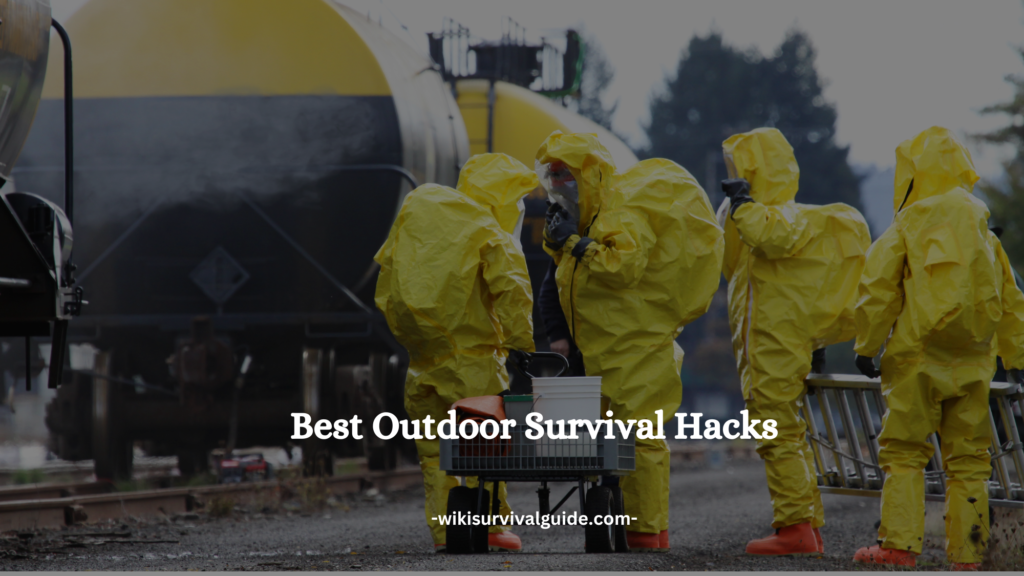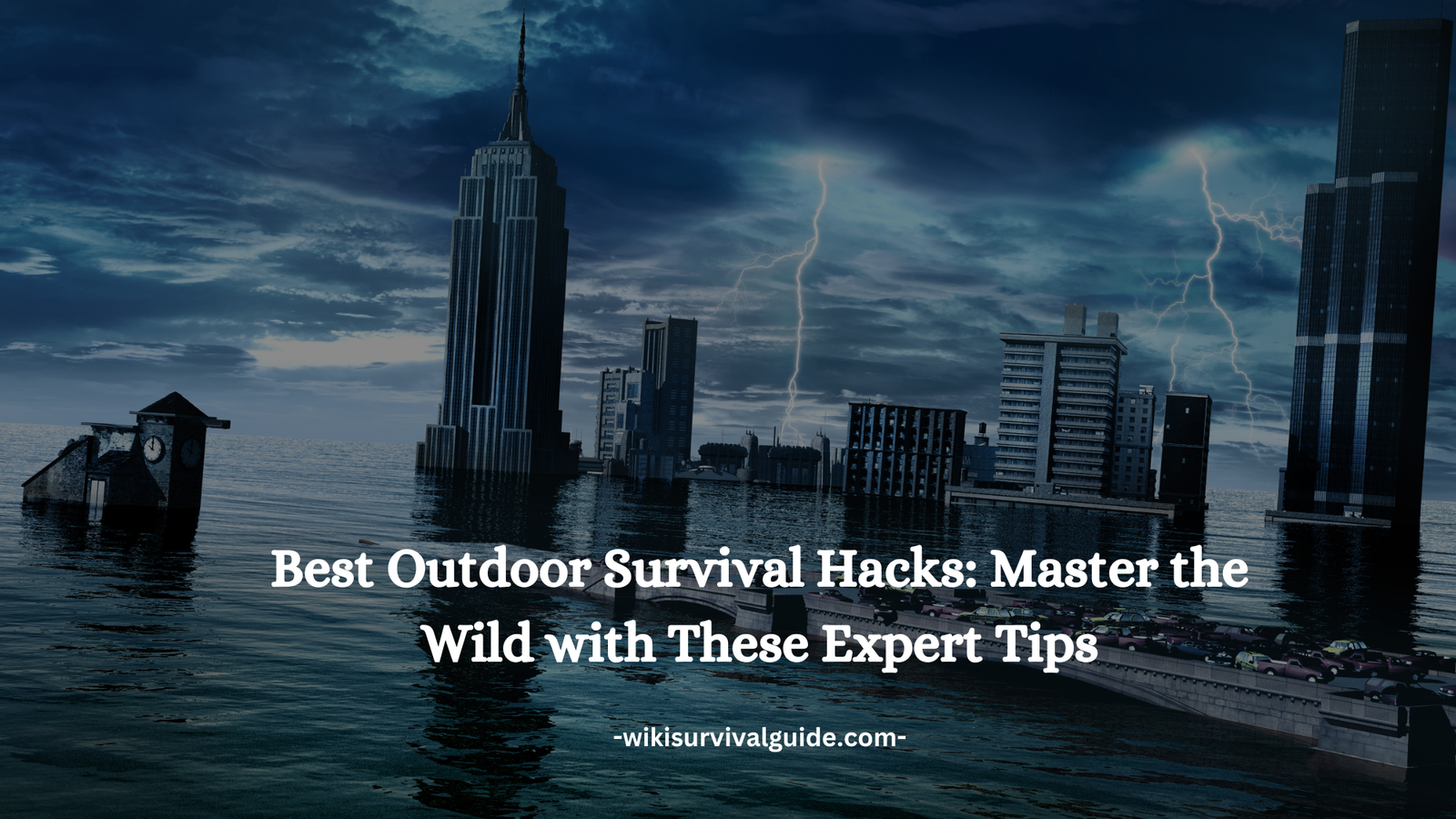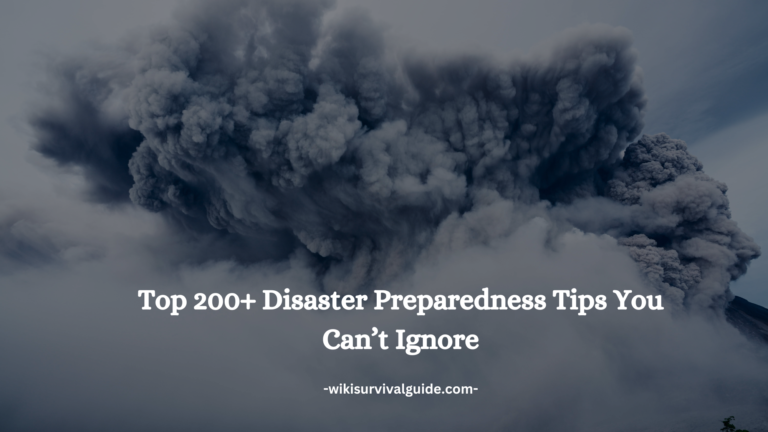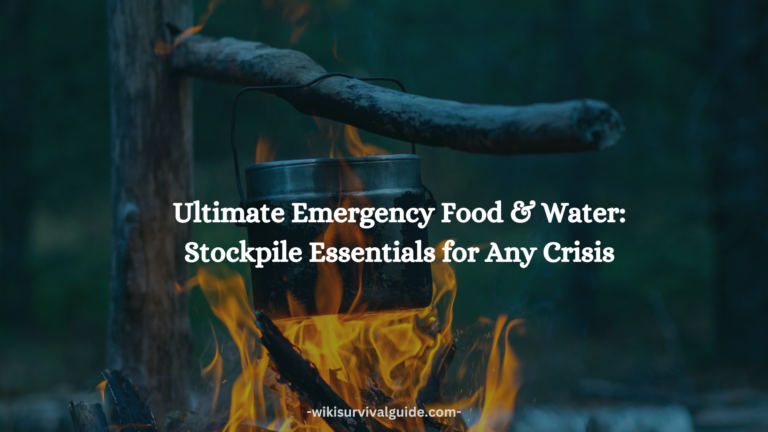Survival in the wild isn’t just about brute strength; it’s about strategy, preparation, and knowing the right hacks to stay alive. Whether you’re lost in the woods or just enjoying a remote camping trip, understanding key survival skills can make all the difference. In this guide, we’ll uncover the best outdoor survival hacks: master the wild with these expert tips to help you navigate, find food, build shelter, and stay safe.

The Survival Mindset: Think Smart, Stay Alive
Survival isn’t just about having the right tools; it’s about having the right mindset. Your ability to think clearly, stay calm, and adapt to any situation is what will ultimately keep you alive in the wild.
The Importance of a Survival Mindset
When faced with an emergency, panic is your worst enemy. Fear clouds judgment, leading to poor decisions that can put you in even greater danger. A survival mindset means staying level-headed, assessing your surroundings, and making strategic moves to ensure your safety.
The Rule of Threes: Setting Priorities
One of the best ways to stay focused in a survival situation is by following the Rule of Threes:
You can survive:
- Three minutes without air – Focus on breathing and avoiding suffocation.
- Three hours without shelter – Prioritize building a safe and insulated place to stay.
- Three days without water – Find and purify water as soon as possible.
- Three weeks without food – Food is important, but it’s not the first priority.
Adaptability and Problem-Solving
Survival often means thinking outside the box. If you lose your gear, can you improvise? If your food supply runs out, do you know how to forage? The ability to adapt to changing circumstances is what separates survivors from victims.
Staying Positive and Mentally Tough
A strong mindset isn’t just about knowledge—it’s also about mental endurance. Staying hopeful, setting small goals, and keeping a sense of humor can prevent hopelessness from taking over. The wild is unpredictable, but with the right survival mindset, you’ll always have an advantage.
Essential Gear: Must-Have Tools for Outdoor Survival
Having the right gear can mean the difference between life and death in the wilderness. While skills are crucial, having essential survival tools on hand will make your journey safer and more manageable.
Multi-Purpose Survival Gear
A good survivalist never packs unnecessary weight. Every item should serve multiple purposes. The following are the top must-have survival tools:
1. Multi-Tool or Survival Knife
- Used for cutting, carving, and self-defense.
- Can be used to start fires, skin animals, or build shelter.
2. Fire Starter Kit
- Waterproof matches, lighters, and magnesium rods are ideal.
- Keeping a small stash of dry tinder ensures you can start a fire anytime.
3. First Aid Kit
- Bandages, antiseptic wipes, and painkillers are necessary for treating wounds.
- Include survival medicine like activated charcoal for poisoning cases.
4. Water Filtration System
- A portable water filter or purification tablets can prevent dehydration.
- Carry a metal container for boiling water as a backup purification method.
5. Paracord and Duct Tape
- Can be used to create shelters, repair gear, or set traps.
- A roll of duct tape is useful for quick fixes on broken gear.
Choosing Lightweight and Durable Gear
Weight matters in survival situations. The lighter your pack, the more mobile you’ll be. Look for compact, multi-functional gear made from durable materials that can withstand extreme conditions.
Testing and Familiarizing Yourself with Gear
Having gear isn’t enough—you need to know how to use it. Regularly practice fire-starting, shelter-building, and first aid skills so you’re not struggling when the time comes. With the right tools and knowledge, survival becomes a lot more manageable.
Wilderness Navigation: Finding Your Way Without GPS
Losing your way in the wilderness can be terrifying, but with proper navigation skills, you can find your way back to safety. GPS devices and phone maps are useful, but they can fail. Knowing how to navigate using natural clues and simple tools is an essential survival skill.
Using a Map and Compass
A traditional map and compass are still the most reliable navigation tools.
How to Use a Compass for Navigation
- Always keep your compass flat to get an accurate reading.
- Find true north and orient your map accordingly.
- Learn to take bearings and follow them in a straight line.
Reading a Topographic Map
- Contour lines show elevation changes—closely packed lines indicate steep terrain.
- Water sources like rivers and lakes serve as landmarks.
Natural Navigation Techniques
Even without a map or compass, nature can help you find your way.
Using the Sun
- The sun rises in the east and sets in the west. In the Northern Hemisphere, shadows cast at noon point north.
Using the Stars
- At night, locate the North Star (Polaris), which always points north.
Observing Water Flow
- Rivers usually flow downhill and often lead to civilization.
Avoiding Common Navigation Mistakes
- Don’t walk in circles—mark your direction and keep a steady course.
- Stay aware of your surroundings—take note of unique landmarks to retrace your steps if needed.
- If lost, stop moving and assess your situation before deciding on the next steps.
With proper navigation knowledge, you can confidently explore the wilderness and find your way back to safety if things go wrong.
Shelter Building Techniques: Stay Warm and Safe
Shelter is one of the most important survival priorities, especially in extreme weather conditions. Exposure to the elements can kill faster than dehydration or hunger. Knowing how to build an effective shelter ensures warmth, protection, and rest.
Choosing the Best Shelter Location
Where you set up your shelter is just as important as the shelter itself.
Avoid These Locations:
- Low-lying areas prone to flooding.
- Under dead or weak branches (widow-makers).
- Too close to animal trails or dens.
Look for These Features:
- A natural windbreak (rock formations, hills).
- Soft ground for insulation.
- Nearby water source (but not too close to avoid flooding).
Types of Survival Shelters
Different environments require different shelters. Here are the most efficient survival shelters:
1. Lean-To Shelter
- Ideal for quick protection from wind and rain.
- Built by leaning branches against a fallen log or rock.
2. Debris Hut
- Provides warmth and insulation in cold climates.
- Constructed using a frame of sticks covered with leaves and foliage.
3. Tarp Tent
- A simple but effective waterproof shelter.
- Can be set up using paracord and stakes to create a sturdy cover.
Insulation and Waterproofing Tips
- Use dry leaves, moss, or pine needles as insulation.
- Raise your sleeping area off the ground using logs or foliage to retain heat.
- Cover the roof with branches or extra layers of tarp for rain protection.
Building a Shelter in Emergency Situations
- Work fast before nightfall—shelters take longer to build than expected.
- If you don’t have tools, use natural formations like caves or overhangs.
- Always test your shelter’s stability before sleeping inside.
Fire-Making Hacks: Start a Fire in Any Condition
Fire is essential for survival—it provides warmth, protection, a way to cook food, and a signal for rescue. However, starting a fire in harsh conditions can be challenging. Knowing fire-making hacks ensures you can light a fire anytime, anywhere.
Essential Fire-Starting Tools
Having the right tools makes fire-starting easier. Always carry:
1. Waterproof Matches and Lighters
- Store them in a waterproof container to prevent moisture damage.
- Lighters work best in dry conditions, but they may fail in extreme cold.
2. Ferro Rod or Magnesium Fire Starter
- Works even when wet and lasts thousands of strikes.
- Scrape magnesium shavings onto tinder before igniting with sparks.
3. Cotton Balls with Petroleum Jelly
- Burns longer than regular tinder, making fire-starting easier.
- Store in a sealed bag for emergency use.
Finding Natural Tinder in the Wild
Even without fire-starting materials, nature provides plenty of flammable tinder:
Dry Tinder Sources:
- Birch bark (ignites even when damp)
- Dead grass, pine needles, and dry moss
- Feather sticks (thin wood shavings curled with a knife)
Homemade Tinder:
- Wax-dipped cotton pads
- Dried lint from your pockets
Fire-Building Techniques for Different Conditions
1. Teepee Fire (Fast Ignition)
- Place small twigs and kindling in a cone shape.
- As the fire grows, add larger logs around the flames.
2. Log Cabin Fire (Longer Burn Time)
- Stack logs in a square crisscross pattern for better airflow.
- Ideal for cooking and maintaining heat through the night.
3. Upside-Down Fire (Best for Wet Conditions)
- Start with large logs at the bottom, smaller kindling on top.
- Prevents the fire from being smothered by damp ground.
Fire-Starting in Extreme Conditions
- Wet weather: Use tree resin or fatwood, which ignites even when damp.
- Windy conditions: Dig a small fire pit or build a windbreak with rocks.
- Cold temperatures: Keep firewood inside your shelter to prevent freezing.
Mastering these fire-making hacks ensures you’re never left in the cold, no matter the conditions.
Finding and Purifying Water: Stay Hydrated in the Wild
Water is the most important survival resource—without it, dehydration can set in within three days. Knowing how to find and purify water in the wild is a critical survival skill.
Finding Natural Water Sources
1. Follow Animal Tracks and Insects
- Birds and insects often gather around water sources.
- Look for animal trails leading downhill toward rivers or lakes.
2. Collect Rainwater
- Use a tarp, plastic sheet, or large leaves to gather rainwater.
- Place containers under tree branches to catch dripping water.
3. Morning Dew and Plant Transpiration
- Tie a plastic bag around green leaves—moisture collects inside from plant respiration.
- Wipe morning dew off grass with a cloth and squeeze it into a container.
Purification Methods to Make Water Safe
Even clear-looking water may contain bacteria and parasites. Always purify before drinking.
1. Boiling Water
- Bring water to a rolling boil for at least one minute (three minutes at high altitudes).
- This is the most effective purification method.
2. Portable Water Filters
- Lightweight straw-style filters remove bacteria and protozoa.
- Pump-style filters work well for large amounts of water.
3. Purification Tablets or Drops
- Iodine or chlorine tablets kill most bacteria.
- Wait 30 minutes before drinking.
4. DIY Solar Water Purification
- Fill a clear plastic bottle and leave it in direct sunlight for 6 hours.
- UV rays help kill bacteria.
Avoiding Contaminated Water Sources
- Never drink stagnant water—it’s a breeding ground for bacteria.
- Avoid water near animal carcasses or waste.
- If water smells bad or has a strange color, it’s best to purify it multiple times.
With the right knowledge, you’ll never go thirsty in the wild.
Wild Food Foraging: What’s Safe to Eat and What’s Not
Foraging is a great way to supplement food in a survival situation, but eating the wrong plant or mushroom can be fatal. Knowing how to identify edible wild plants is crucial.
Rules of Safe Foraging
1. Follow the Universal Edibility Test
If unsure, test the plant in steps:
- Smell it—avoid anything with a strong bitter or soapy odor.
- Rub a small piece on your inner wrist—wait 15 minutes for irritation.
- Take a tiny bite, hold it in your mouth for five minutes, and spit it out.
- If no reaction after eight hours, swallow a small amount.
2. Learn Poisonous Plant Traits
Avoid plants with:
- Milky sap
- Thorns or spines
- Almond-like smell (cyanide in some plants)
Edible Plants and Fungi
1. Wild Berries (Safe vs. Dangerous)
- Safe: Blueberries, blackberries, raspberries.
- Avoid: Bright red or white berries, which are often toxic.
2. Nuts and Seeds
- Acorns (soaked to remove tannins) are rich in nutrients.
- Pine nuts from pinecones are safe and high in calories.
3. Edible Roots and Leaves
- Dandelions: Leaves, flowers, and roots are all edible.
- Cattails: Found near water; the roots and shoots are safe to eat.
Fungi: The Risk of Deadly Mushrooms
- If you’re not 100% sure it’s safe, don’t eat it.
- Avoid mushrooms with white gills or a bulbous base, as they often indicate toxicity.
Foraging takes knowledge, but once mastered, nature provides plenty of food.
Hunting and Fishing for Survival: Catching Your Next Meal
Hunting and fishing are essential survival skills when food is scarce. Knowing how to trap animals and catch fish can provide long-term sustenance.
Hunting Small Game
1. Setting Up Simple Traps
- Figure-Four Deadfall: Uses a rock and sticks to crush small animals.
- Snare Trap: A loop of wire or paracord catches rabbits or squirrels.
2. Tracking Animal Signs
- Look for footprints, droppings, and fur caught on bushes.
- Set traps along game trails or near water sources.
3. Improvised Hunting Tools
- Spear-fishing: Carve a sharp stick and hunt fish in shallow water.
- Slingshots or bows can be made from branches and paracord.
Fishing for Survival
1. Hand Fishing (Noodling)
- In shallow water, reach under rocks and grab fish by hand.
- Works best for slow-moving fish like catfish.
2. DIY Fishing Hooks and Lines
- Use thorns, bones, or bent safety pins as makeshift hooks.
- Fishing line can be replaced with paracord strands or plant fibers.
3. Fish Traps
- Weave a funnel-shaped trap from branches and place it in a stream.
- Fish swim in and get stuck, making catching them easier.
Cooking and Preserving Meat
- Cook thoroughly over a fire to kill parasites.
- Smoke or dry fish and meat for long-term storage.
Extreme Weather Survival: Hot and Cold Climate Strategies
Surviving in extreme weather requires knowing how to regulate body temperature, prevent dehydration, and protect yourself from the elements. Whether facing scorching heat or freezing cold, the right strategies can mean the difference between life and death.
Hot Climate Survival
In a hot environment, dehydration and heat exhaustion are your biggest threats.
1. Preventing Dehydration
- Drink water frequently—even before you feel thirsty.
- Look for shade during the hottest parts of the day.
- Avoid sweating too much—slow down and rest often.
2. Finding Shelter from the Sun
- Natural shade: Rest under trees or large rocks.
- DIY shelters: Use a tarp or large branches to create a shaded area.
3. Cooling the Body Efficiently
- Dampen a cloth and place it on your wrists, neck, and forehead.
- Dig a shallow pit in the sand and lie in it to stay cool.
Cold Climate Survival
In cold weather, hypothermia and frostbite are the biggest dangers.
1. Dressing in Layers to Retain Heat
- Base layer: Wicks sweat away (avoid cotton).
- Middle layer: Insulates with wool or fleece.
- Outer layer: Waterproof and wind-resistant.
2. Building a Heat-Trapping Shelter
- Snow caves or lean-tos help trap body heat.
- Use tree branches or insulation from leaves to cover the shelter.
3. Staying Warm at Night
- Sleep off the ground to avoid heat loss.
- Heat rocks near a fire and place them inside your shelter.
Mastering these climate strategies ensures you’re prepared for any weather challenge the wild throws at you.
First Aid in the Wild: Treating Common Injuries
Medical help is often far away in survival situations. Knowing how to treat injuries quickly and correctly can save lives.
Treating Cuts and Wounds
1. Stop the Bleeding
- Apply direct pressure with a clean cloth.
- Elevate the wound above the heart.
2. Prevent Infection
- Rinse with clean water or boil water if needed.
- Use natural antiseptics like honey or pine sap if no first-aid kit is available.
3. Bandaging the Wound
- Use cloth strips or plant fibers as a makeshift bandage.
- Change dressings regularly to prevent infection.
Handling Broken Bones or Sprains
1. Creating a Splint
- Use sticks or rolled fabric to immobilize the limb.
- Tie it securely but not too tight to cut off circulation.
2. Reducing Swelling
- Elevate the injured area and apply a cold compress (snow or cold water).
Dealing with Burns
- Cool the burn with clean water for at least 15 minutes.
- Avoid popping blisters, as they protect against infection.
- Apply aloe vera, honey, or plantain leaves for relief.
Knowing basic first aid ensures minor injuries don’t turn into life-threatening problems.
Emergency Signaling: How to Call for Rescue
If lost or stranded, signaling for help increases your chances of rescue. The key is visibility and sound.
Visual Signals
1. Fire and Smoke Signals
- A three-smoke signal (three separate fires) is a universal distress sign.
- Green leaves on the fire create thicker smoke for visibility.
2. Creating Ground Markers
- Spell SOS or large arrows using rocks, logs, or snow.
- The bigger, the better—aim for 10+ feet in size.
3. Using a Signal Mirror
- Reflect sunlight toward planes or search parties.
- Flashing the mirror in short bursts gets more attention.
Audio Signals
1. Whistles and Shouting
- A three-whistle blast means distress.
- If no whistle, bang on trees or use your voice at regular intervals.
2. Using Flares or Flashlights
- Flash your light three times in a row to signal distress.
- At night, use a torch or flashing object to increase visibility.
A good emergency signal plan helps rescuers find you faster.
Predator and Wildlife Safety: Avoiding Dangerous Encounters
Wild animals aren’t out to get you, but if startled or provoked, they can become a real threat. Knowing how to react prevents dangerous encounters.
Preventing Wildlife Conflicts
1. Store Food Properly
- Hang food 10+ feet off the ground to avoid attracting bears.
- Keep campsites clean and trash stored away.
2. Avoiding Surprise Encounters
- Make noise while hiking in bear country.
- Watch for tracks, droppings, or fresh claw marks.
How to React to Different Animals
1. Bears
- Black bears: Make yourself look big and make loud noises.
- Grizzlies: Play dead if attacked—lie on your stomach and cover your head.
2. Wolves and Coyotes
- Maintain eye contact and do not run—back away slowly.
- If attacked, fight back aggressively.
3. Snakes
- If bitten, stay calm and keep the limb still.
- Do not suck out the venom—seek medical help ASAP.
Being aware of your surroundings keeps wildlife encounters safe, not dangerous.
Clothing and Layering Strategies for Outdoor Survival
The right clothing can make or break your survival chances. Layering helps regulate body temperature and protect against the elements.
Layering for Maximum Protection
1. Base Layer (Moisture-Wicking)
- Avoid cotton, as it absorbs sweat and makes you cold.
- Use merino wool or synthetic fabrics instead.
2. Middle Layer (Insulation)
- Fleece, wool, or down jackets trap body heat.
- Adjust layers as needed to prevent overheating.
3. Outer Layer (Weather Protection)
- A windproof and waterproof shell blocks rain and cold wind.
- Ventilation zippers help release excess heat.
Clothing Tips for Different Conditions
Hot Weather Survival
- Wear light-colored, loose clothing to reflect heat.
- Use a wide-brim hat and sunglasses for sun protection.
Cold Weather Survival
- Wear mittens instead of gloves—they retain more heat.
- Keep feet dry with waterproof boots and thick socks.
Wet Weather Protection
- Pack a lightweight rain poncho.
- Keep spare clothes in a dry bag.
Dressing smart keeps you comfortable and alive in extreme conditions.
Mental and Physical Endurance: Staying Strong in the Wild
Survival isn’t just about having the right gear—it’s also about mental resilience and physical endurance. Your body and mind must be prepared to handle stress, exhaustion, and unexpected dangers.
Building Mental Strength for Survival
1. Stay Calm Under Pressure
- Panic leads to poor decision-making and wasted energy.
- Take deep breaths, assess your situation, and create a plan.
2. Develop a Survival Mindset
- Believe in your ability to overcome challenges.
- Adapt to changing conditions and stay optimistic.
3. Manage Stress and Fear
- Use mental techniques like positive self-talk and visualization.
- Keep your mind occupied with small tasks to avoid panic spirals.
Enhancing Physical Endurance
1. Build Stamina Before You Need It
- Regularly hike with a weighted backpack.
- Improve cardiovascular endurance with running or swimming.
2. Strengthen Key Muscles
- Focus on leg strength for hiking and core strength for balance.
- Train with bodyweight exercises like push-ups, squats, and planks.
3. Conserve Energy in Survival Situations
- Move at a steady pace—don’t rush and waste energy.
- Prioritize food and water to maintain strength.
A strong mind and body increase your chances of survival in extreme situations.
Improvised Survival Tools: Making Do with What You Have
When stranded, knowing how to create tools from your surroundings is a game-changer.
Improvised Weapons and Tools
1. DIY Knife or Cutting Tool
- Sharpen a rock or metal piece against another stone.
- Wrap cloth or rope around it for a better grip.
2. Rope and Cordage from Natural Materials
- Strip plant fibers or bark and twist them into strong ropes.
- Use shoelaces or clothing strips for quick tie-downs.
3. Fishing Hooks and Snares
- Bend metal (paperclips, wire, or bone) into a fishing hook.
- Use flexible branches and a simple trigger to make an animal snare.
DIY Fire Starters
1. Battery and Steel Wool
- Touch steel wool to a battery to create an instant spark.
2. Rock and Metal Strike
- Strike flint or quartz against a knife to produce sparks.
Making use of everyday objects and nature can mean the difference between life and death.
Common Survival Mistakes and How to Avoid Them
Even experienced adventurers make mistakes that can cost them their lives. Avoiding these pitfalls greatly improves your survival odds.
Navigation Mistakes
1. Moving Without a Plan
- Walking without direction wastes energy and can make you more lost.
- Use natural landmarks and the sun to guide you.
2. Ignoring Your Surroundings
- Always be aware of weather changes, predators, and available resources.
- Mark trees or rocks as waypoints to track where you’ve been.
Shelter and Clothing Mistakes
1. Not Prioritizing Shelter
- Exposure is deadlier than thirst or hunger.
- Find shelter before nightfall to retain body heat.
2. Dressing for the Wrong Weather
- Cotton kills in wet conditions—it traps moisture and causes hypothermia.
- Layer correctly and pack a waterproof outer layer.
Food and Water Mistakes
1. Drinking Contaminated Water
- Always boil, filter, or chemically treat water before drinking.
2. Eating the Wrong Plants
- Some berries, mushrooms, and plants are toxic.
- If unsure, don’t eat it—stick to universally safe options like acorns and cattails.
Avoiding these mistakes can mean the difference between life and death.
Urban Survival vs. Wilderness Survival: Key Differences
Survival skills differ based on where you are—a city and a remote forest pose very different challenges.
Urban Survival Basics
1. Securing Water and Food
- Tap water may be contaminated—use filters or bottled sources.
- Know where to find emergency food, like grocery stores or community shelters.
2. Dealing with Crowds and Security Risks
- In urban disasters, people can be as dangerous as the environment.
- Stay low-profile, avoid drawing attention, and secure your home.
Wilderness Survival Basics
1. Navigating Without GPS
- Use landmarks, the sun, and stars to guide you.
- Always carry a compass or make one using a magnetized needle.
2. Finding and Purifying Water
- Look for streams, rainwater, or underground springs.
- Use boiling, charcoal filtering, or chemical tablets to purify.
While both require resourcefulness, urban survival is about security, while wilderness survival is about nature’s elements.
Real-Life Survival Stories and Lessons Learned
Learning from real survival stories helps us prepare for the unexpected.
The Miracle of Juliane Koepcke
- In 1971, 17-year-old Juliane Koepcke survived a plane crash in the Amazon.
- She walked for 11 days alone, using knowledge from her father about following water sources to civilization.
Lesson: Rivers and streams often lead to rescue—follow them if lost.
Aron Ralston’s Unbreakable Will
- In 2003, hiker Aron Ralston got trapped under a boulder in Utah.
- After six days, he amputated his arm using a dull knife to escape.
Lesson: Always tell someone where you’re going before heading into the wild.
Mauro Prosperi’s Sahara Ordeal
- In 1994, Mauro Prosperi got lost in the Sahara Desert during a marathon.
- He survived 9 days alone, drinking bat blood and eating small animals.
Lesson: Even in extreme heat, ration water wisely and find shade.
These stories remind us that the right mindset and knowledge can make all the difference.
Conclusion
Surviving in the wild isn’t about luck—it’s about knowledge and preparation. By following these best outdoor survival hacks: master the wild with these expert tips, you’ll be ready for any adventure. Stay prepared, stay smart, and always respect nature.
FAQs
- What’s the most important survival skill to learn first?
Fire-making and water purification should be your top priorities. - How do I start a fire if everything is wet?
Look for dry tinder under tree bark or use cotton balls with petroleum jelly. - What are the best ways to find food in the wild?
Foraging, fishing, and small game trapping are the most reliable methods. - How do I purify water without a filter?
Boiling is the safest way, but you can also use charcoal and sand filtration. - What’s the safest way to signal for help in an emergency? Using a signal mirror, building a fire, or creating ground signals are your best options.




1 Comment